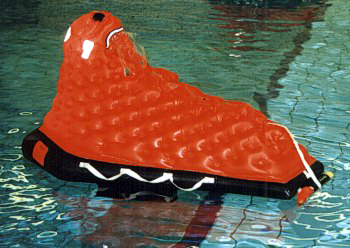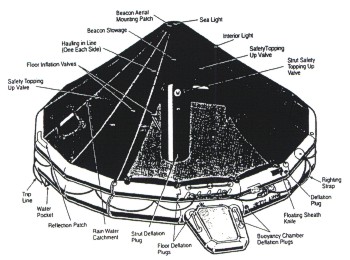Introduction
To provide protection for survivors, all aircraft flying over
the sea normally carry sufficient liferafts for the crew and
passengers. Several types of liferaft are used and the type
title is synonymous with the number of people the liferaft is
designed to carry. For example the type SS is a single seat
liferaft and the type MS 26 is a multiseat liferaft designed to
carry 26 people. All liferafts are designed with 50% 'reserve'
buoyancy which permits a considerable overload. This chapter
aims briefly to describe various types of liferaft.
Single Seat Liferafts
The single seat liferaft is always fitted in a personal survival
pack. The type of personal survival pack will depend on the
aircraft in which it is fitted, and in most cases it forms part
of the seat of the aircraft. There are several marks of single
seat liferaft currently available. In general they are similar
and vary only in detail.
SS Mk 15 Liferaft
The buoyancy chamber is inflated from a carbon dioxide cylinder
operated by a lanyard. Should further inflation be required, it
may be done via an inflation point on the buoyancy chamber
adjacent to the occupant's left thigh. The floor consists of a
double layer of quilted fabric which can be orally inflated by a
tube located at the occupant's right hip to provide insulation
between the survivor and the sea. The canopy is also double
skinned and quilted. This may be inflated by means of a tube and
valve situated near the occupant's right shoulder. The canopy
incorporates a hood and visor which can be pulled over the head
and face. The buoyancy chamber and floor of the SS Mk 15 are
black or dark grey in color and the canopy fluorescent flame
orange. The single seat liferaft is attached to the survivor by
a lanyard connected to the life preserver. This connection
should not be released until a rescue ship or helicopter has
secured the survivor.

a single seat liferaft
Multi-seat
liferafts
Various types of multi-seat liferaft are currently in use. Among
them are types designated as MS 5, MS 10, MS 26 and MS 33. The
exact location and stowage medium of the liferaft(s) in an
aircraft will depend on the aircraft type. No liferaft
installation is considered to be satisfactory if the liferaft
cannot be released, launched and inflated by one man. To make
this possible some mechanical assistance may be provided to
relieve the operator of some or all of the bulk and weight of
the liferaft installation. The MS 10 is considered to be the
largest liferaft which can be lifted by one person.
Blow Out Stowage
Blow out systems for multi-seat liferafts are provided in some
aircraft. In these aircraft, the liferafts and survival aids are
stored in panniers in compartments integral with the aircraft
wing or engine nacelle. The system is operated by pulling an
operating handle in the aircraft, the liferaft compartment cover
lifts off, closely followed by. the inflating liferaft. If the
interior handle fails to initiate the release sequence, an
alternative control close to, or within, the stowage compartment
can be used to release the liferaft.
Valise Stowage
In aircraft not fitted with blow out stowage facilities the
liferaft is carried inside the fuselage. In these cases the
liferaft may be packed into a valise. The valise is a canvas bag
with webbing handles and is held closed by a lace. Should it be
necessary to use the liferaft, a nylon line from the valise is
connected to an aircraft strong point and the valise is thrown
into the sea.
The nylon line is attached to the liferaft and to the inflation
cylinder. When the line is pulled, the liferaft inflates and
bursts out of the valise by breaking the lace.
Container Stowage
Container Stowage is a development of the valise stowage method.
The containers are made from rigid plastic material and shaped
to suit the requirements of particular aircraft. Some containers
are disc shaped and therefore may be easily rolled from their
stowage position to emergency exit. The liferaft in a container
is inflated by a method similar to that employed on a liferaft
stowed in a valise.
Design
The design characteristics of all multi-seat liferafts are
similar although individual types vary in detail. They are
normally inflated from carbon dioxide filled cylinders operated
by a lanyard. The canopy is held up by inflatable pillars and is
fitted with rainwater catchments areas. The liferaft floor and
canopy are double skinned to provide thermal insulation but only
the floor can be inflated by means of the bellows via one or
more inflation points. All multi-seat liferafts except the MS 5
are fitted with two entrances and inflatable ramps to assist
boarding. Water pockets under the liferaft provide improved
stability in rough sea conditions.
MS 26 Liferaft
The picture below shows an MS 26 multiseat life raft. A
central inflated pillar rises from the floor to support a double
layered canopy. The two doors of the liferaft have double
closure panels. In addition to the doors there are two
observation apertures in the canopy, at right angles to the
doors. These apertures can be closed with sleeves which are not
inflatable. The canopy has rainwater catchment ducts on the
sides, terminating in tubes inside, the liferaft.

MS26 multi seat liferaft
|